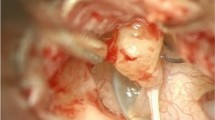Abstract
Chronic suppurative otitis media, with and without cholesteatoma, frequently results in disruption of the ossicular chain. The present study was designed to compare the outcome using autologous ossicle and titanium prosthesis in two groups of suitable patients presenting with chronic suppurative otitis media for middle ear reconstructive surgeries. A prospective study done from July 2012 to December 2013, at Mahatma Gandhi Medical College and Hospital, Sitapura, Jaipur (Rajasthan). The target group included patients with chronic suppurative otitis media admitted and planned for reconstructive middle ear surgery. The study group patients among the target group requiring certain ossicular reconstruction. The patients included were patients with CSOM with or without cholesteatoma in which there was ossicular discontinuity. The patients were divided in two groups A and B. In group A patients autologous incus was used and in group B titanium prosthesis either TORP or PORP was used for ossicular replacement. Out of 340 patients as target group, 88 patients were included in study group. Further 88 patients of study group, 51 patients were included in group A; rest 37 patients were included in group B. In group B patients partial ossicular replacement platinum prosthesis was used in 31 patients while in rest 6 patients a total ossicular replacement prosthesis was used. Out of 88 patients, 79 were primary cases and 9 were revision cases. Pre and post operative air bone gap were noted. Pre operatively both of the groups were identical in relation to air–bone gap. The postoperative air–bone gap was calculated as the difference between postoperative air conduction and preoperative bone conduction. On comparison of preoperative and post-operative hearing results there was improvement in air conduction threshold and air bone gap in both the groups. Post operatively difference in air bone gap closure between group A and group B was found statistically significant (P value = 0.032) suggesting better hearing outcomes after using titanium ossicular replacement prosthesis. On comparing partial or total ossicular replacement prosthesis no significant difference was found for the audiological outcome (P = 0.434). Various prognostic factors were also noted for air bone gap closure. Titanium ossicular replacement prosthesis have better outcome, and no significant difference found in audiological outcome for TORP and PORP.
Similar content being viewed by others
References
Batti JS (2004) Ossicular discontinuity/fixation. Chapter 84. Advanced therapy of Otitis Media. BC Dekar, 414
Javia LR, Ruckenstein MJ (2006) Ossiculoplasty. Otolaryngol Clin North Am 39(6):1177–1189
Frootko NJ (2008) Reconstruction of middle ear. Scott Brown’s otorhinolaryngology, head and neck surgery, 7th edn. Hodder Arnold, London
Mudhol RS, Naragund AI, Shruthi VS (2013) Ossiculoplasty: revisited. Indian J Otolaryngol Head Neck Surg 65(Suppl 3):451–454. doi:10.1007/s12070-011-0472-7
Glasscoc MG, Gulya A (eds) (2007) Glasscock-Shambangh surgery of the ear, 5th edn. Elsevier, Toronto
Dornhoffer JL, Gardner E (2001) Prognostic factors in ossiculoplasty: a statistical staging system. Otol Neurotol 22:299–304
Black B (1992) Ossiculoplasty prognosis: the SPITE method of assessment. Am J Otol 13(6):544–551
Albu S, Babighian G, Trabalzini F (1998) Prognostic factors in tympanoplasty. Am J Otol 19(2):136–140
Kim HH, Wiet RJ (2003) Preferred technique in ossiculoplasty. Oper Tech Otolaryngol Head Neck Surg 14:243–246
Yung MW (2003) Literature review of alloplastic materials in ossiculoplasty. J Laryngol Otol 117:431–436
Michael P, Fong J, Raut V (2008) Kurz titanium prostheses in paediatric ossiculoplasty: short-term results. Int J Pediatr Otorhinolaryngol 72:1329–1333
Alaani A, Raut VV (2010) Kurz titanium prosthesis ossiculoplasty—follow-up statistical analysis of factors affecting one-year hearing results. Auris Nasus Larynx 37:150–154
Schmerber S, Troussier J, Dumas G et al (2006) Hearing results with the titanium ossicular replacement prostheses. Eur Arch Otorhinolaryngol 263:347–354
Morris DP, Bance M, Van Wijhe RG (2004) How do cartilage and other material overlay over a prosthesis affect its vibration transmission properties in ossiculoplasty? Otolaryngol Head Neck Surg 131:423–428
Murbe D, Zahnert T, Bornitz M et al (2002) Acoustic properties of different cartilage reconstruction techniques of the tympanic membrane. Laryngoscope 112:1769–1776
Jha S, Mehta K, Prajapati V, Patel D, Kharadi P (2011) A comparative study of ossiculoplasty using various graft Materials. NJIRM 2(4):53–56
Vassbotn FS, Moller P, Silvola J (2007) Short-term results using Kurz titanium ossicular implants. Eur Arch Otorhinolaryngol 264:21–25
Hales NW, Shakir FA, Saunders JE (2007) Titanium middle-ear prostheses in staged ossiculoplasty: does mass really matter? Am J Otolaryngol Head Neck Med Surg 28:164–167
Jackson CG, Glasscock ME, Schwaber MK, Nissen AJ, Christiansen SG, Smith PG. Ossicular chain reconstruction: the TORP and PORP in chronic ear disease. Laryngoscope 1983; 93(8):981–8
Begall K, Zimmermann H (2000) Rekonstruktion der Gehorknochelchenkette mit Titan-Implantaten. Laryngo Rhino Otol 79:139–145
Krueger WW, Feghali JG, Shelton C et al (2002) Preliminary ossiculoplasty results using the Kurz titanium prostheses. Otol Neurotol 23:836–839
Stupp CH, Dalchow CV, Grun D, Stupp HF (2001) Reconstruction of the ossicular chain with titanium implants. Otolaryngol Head Neck Surg 125:628–630
Mishiro Y, Sakagami M, Adachi O, Kakutani C (2009) Prognostic factors for short- term outcomes after ossiculoplasty using multivariate analysis with logistic regression. Arch Otolaryngol Head Neck Surg 135:738–741
Author information
Authors and Affiliations
Corresponding authors
Ethics declarations
Conflict of interest
None.
Rights and permissions
About this article
Cite this article
Kumar, S., Yadav, K., Ojha, T. et al. To Evaluate and Compare the Result of Ossiculoplasty Using Different Types of Graft Materials and Prosthesis in Cases of Ossicular Discontinuity in Chronic Suppurative Otitis Media Cases. Indian J Otolaryngol Head Neck Surg 70, 15–21 (2018). https://doi.org/10.1007/s12070-017-1184-4
Received:
Accepted:
Published:
Issue Date:
DOI: https://doi.org/10.1007/s12070-017-1184-4




